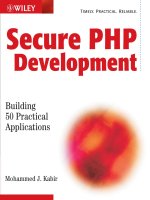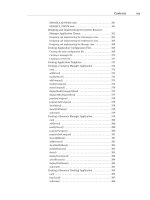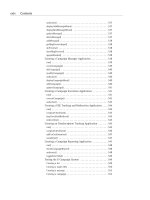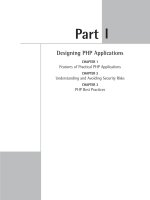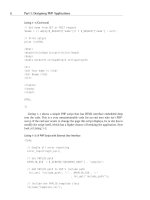Secure PHP Development- P164 pdf
Bạn đang xem bản rút gọn của tài liệu. Xem và tải ngay bản đầy đủ của tài liệu tại đây (125.03 KB, 5 trang )
Configuring the global environment for Apache
The directives discussed in this section create the global environment for the
Apache server. The directives are described in the order in which they appear in the
httpd.conf file.
Whenever we refer to %directive%, we are referring to the value of
the directive set in the configuration file. For example, if a directive
called ServerAdmin is set to , a reference to
%ServerAdmin% means “”. Therefore, if we ask you
to change %ServerAdmin%, you are being asked to change the e-mail
address in question.
The first directive is ServerRoot, which appears as follows:
ServerRoot “/usr/local/apache”
This directive specifies the top-level directory of the Web server. The specified
directory is not where you keep your Web contents. It is the directory where the Web
server program (httpd) and the files/directories that control Apache are on your hard
disk. It is really a directory, which normally has the following subdirectories:
{ServerRoot Directory}
|
| bin
| conf
| htdocs
|
+ manual
| | developer
| | howto
| | images
| | misc
| | mod
| | platform
| | programs
| | search
| + vhosts
|
| icons
| |
| + small
|
Appendix D: Linux Primer 791
34 549669 AppD.qxd 4/4/03 9:28 AM Page 791
| logs
| cgi-bin
+ include
/usr/local/apache
is the parent directory for all server-related files. The
default value for ServerRoot is set to whatever you choose for the prefix
option during source configuration using the configure script. By default, the
make install command executed during server installation copies all the server
binaries in %ServerRoot%/bin, server configuration files in %ServerRoot%/conf,
and so on.
You should change the value of this directive only if you have manually
moved the entire directory from the installation location to another loca-
tion. For example, if you simply run cp -r /usr/local/apache/home/
apache
and want to configure the Apache server to work from the new
location, you will change this directive to ServerRoot/home/apache.
Note that in such a case, you must also change other direct references from
/usr/local/apache to /home/apache.
Also note that whenever you see a relative directory name in the configuration
file, Apache will prefix %ServerRoot% to the path to construct the actual path. You
will see an example of this in the directive in the following section.
PidFile
The PidFile directive is encapsulated within an if condition by using the
<IfModule . . .> container, as shown here:
<IfModule !mpm_netware.c>
PidFile logs/httpd.pid
</IfModule>
This tells Apache to set the PidFile to %ServerRoot%/logs/httpd.pid file only
if you have chosen a multiprocessing module (MPM) other than mpm_netware.c.
The PidFile directive sets the process ID (PID) file path. By default, it is set to
logs/httpd.pid, which translates to %ServerRoot%/logs/httpd.pid (that is,
/usr/local/apache/logs/httpd.pid). Whenever you want to find the PID of the
main Apache process that runs as root and spawns child processes, you can
run the cat %ServerRoot/logs/httpd.pid command. Don’t forget to replace
%ServerRoot% with an appropriate value.
792 Part VII: Appendixes
34 549669 AppD.qxd 4/4/03 9:28 AM Page 792
If you change the %PidFile% value to point to a different location, make
sure the directory in which the httpd.pid file resides is not writable by
anyone but the root user, for security reasons
Timeout, KeepAlive, MaxKeepAliveRequests, and KeepAliveTimeout
Timeout sets the server timeout in seconds. The default should be left alone. The
next three directives KeepAlive, MaxKeepAliveRequests, and KeepAliveTimeout
are used to control the keep-alive behavior of the server.
IfModule containers
Apache will use one of three <IfModule . . .> containers depending on which
MPM you chose. For example, if you configured Apache using the with-
mpm=worker,
multi-threaded MPM (worker), the following <IfModule . . .> con-
tainer will be used:
<IfModule worker.c>
StartServers 2
MaxClients 150
MinSpareThreads 25
MaxSpareThreads 75
ThreadsPerChild 25
MaxRequestsPerChild 0
ServerLimit 16
</IfModule>
If you kept the default prefork MPM during source configuration by using the
configure script, the following <IfModule . . .> container will be used:
<IfModule prefork.c>
StartServers 5
MinSpareServers 5
MaxSpareServers 10
MaxClients 150
MaxRequestsPerChild 0
ServerLimit 16
</IfModule>
Similarly, the with-mpm=perchild option forces Apache to use the last
<IfModule . . .> container.
Because we recommend the worker MPM here, the following sections describe
the directives used for this MPM.
Appendix D: Linux Primer 793
34 549669 AppD.qxd 4/4/03 9:28 AM Page 793
StartServers
StartServers tells Apache to start two child servers as it starts. You can start more
servers if you want, but Apache is pretty good at increasing the number of child
processes as needed based on load. For that reason, changing this directive is not
required.
MaxClients
In threaded (worker) MPM, this directive represents the maximum number of simul-
taneous threads that can be serving requests. In prefork MPM, it represents the
maximum number of simultaneous processes that can be serving the requests. In
worker MPM, when MaxClient is set to 150 and ThreadPerChild is set to 25, six
processes are needed to service 150 simultaneous requests. If you wish to raise this
limit, set ServerLimit accordingly. Suppose you want to service 400 simultaneous
requests per second with 25 threads per process in worker MPM; in such a case, you
need MaxClient set to 400 and ThreadPerChild set to 25, and ServerLimit =
MaxClient / ThreadPerChild = 16.
MinSpareThreads
The MinSpareThreads directive specifies the minimum number of idle threads.
These spare threads are used to service requests, and new spare threads are created
to maintain the minimum spare thread pool size. You can leave the default settings
alone.
MaxSpareThreads
The MaxSpareThreads directive specifies the maximum number of idle threads;
leave the default as is. In the default threaded mode, Apache kills child processes to
control minimum and maximum thread count.
ThreadsPerChild
This directive defines how many threads are created per child process.
MaxRequestPerChild
The final directive for the global environment is MaxRequestPerChild, which sets
the number of requests a child process can serve before getting killed. The default
value of zero makes the child process serve requests forever. We do not like to use
the default value because it enables Apache processes to slowly consume large
amounts of memory when a faulty mod_perl script, or even a faulty third-party
Apache module, leaks memory. Thus, we prefer to set this to 30.
If you do not plan to run any third-party Apache modules or mod_perl
scripts, you can keep the default or set it to a reasonable number. A setting
of 30 ensures that the child process is killed after processing 30 requests. Of
course, a new child process is created as needed.
794 Part VII: Appendixes
34 549669 AppD.qxd 4/4/03 9:28 AM Page 794
Configuring the main server
The main server configuration applies to the default Web site Apache serves. This is
the site that will come up when you run Apache and use the server’s IP address or
host name on a Web browser.
LISTEN The first directive in this section is the
Listen directive, which sets the
TCP port that Apache listens to for connections. The default value of 80 is the stan-
dard HTTP port. If you change this to another number, such as 8080, you can access
the server only using a URL such as http://hostname:8080/. You must specify
the port number in the URL if the server runs on a nonstandard port.
There are many reasons for running Apache on nonstandard ports, but the only
good one we can think of is that you do not have permission to run Apache on the
standard HTTP port. As a non-root user, you can run Apache only on ports higher
than 1024.
After you have decided to run Apache by using a port, you need to tell Apache
what its user and group names are.
USER AND GROUP DIRECTIVES The
User and Group directives tell Apache which
user (UID) and group (GID) names to use. These two directives are very important
for security reasons. When the parent Web server process launches a child server
process to fulfill a request, it changes the child’s UID and GID according to the val-
ues set for these directives.
If the child processes are run as root user processes, a potential security hole will
be opened for attack by hackers. Enabling the capability to interact with a root user
process maximizes a potential breach of security in the system; hence, this is not
recommended. Rather, we highly recommend that you choose to run the child
server processes as a very low privileged user belonging to a very low privileged
group. In most UNIX systems, the user named nobody (usually UID = -1) and the
group named nogroup (usually GID = -1) are low-privileged. You should consult
your /etc/group and /etc/passwd files to determine these settings.
If you plan to run the parent Web server as a nonroot (regular) user, it will not
be able to change the UID and GID of child processes, because only root user
processes can change the UID or GID of other processes. Therefore, if you run your
parent server as the user named ironsheik, all child processes will have the same
privileges as ironsheik. Similarly, whatever group ID you have also will be the
group ID for the child processes.
If you plan to use the numeric format for user and/or group ID, you need to
insert a # symbol before the numeric value, which can be found in
/etc/passwd and /etc/group files.
Appendix D: Linux Primer 795
34 549669 AppD.qxd 4/4/03 9:28 AM Page 795
